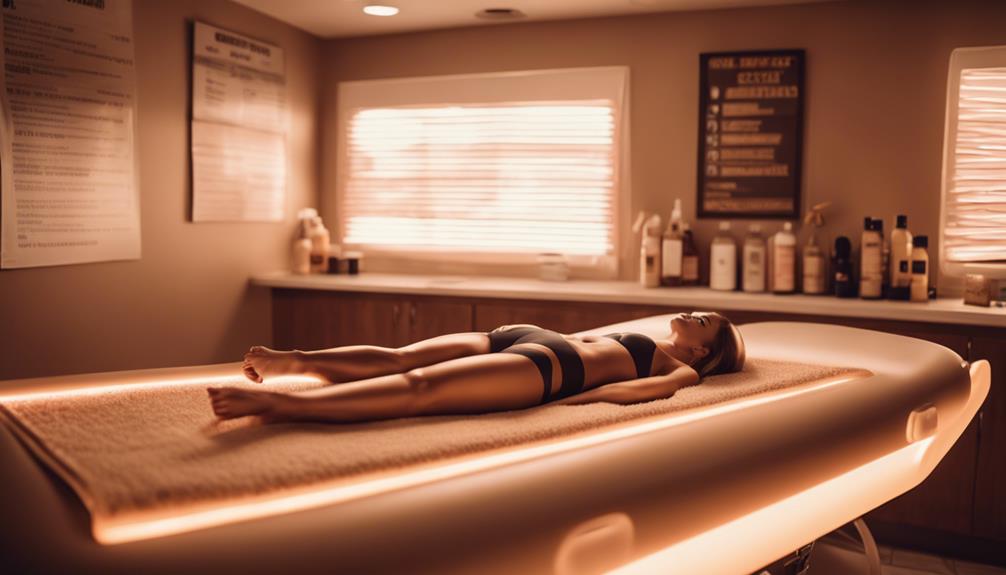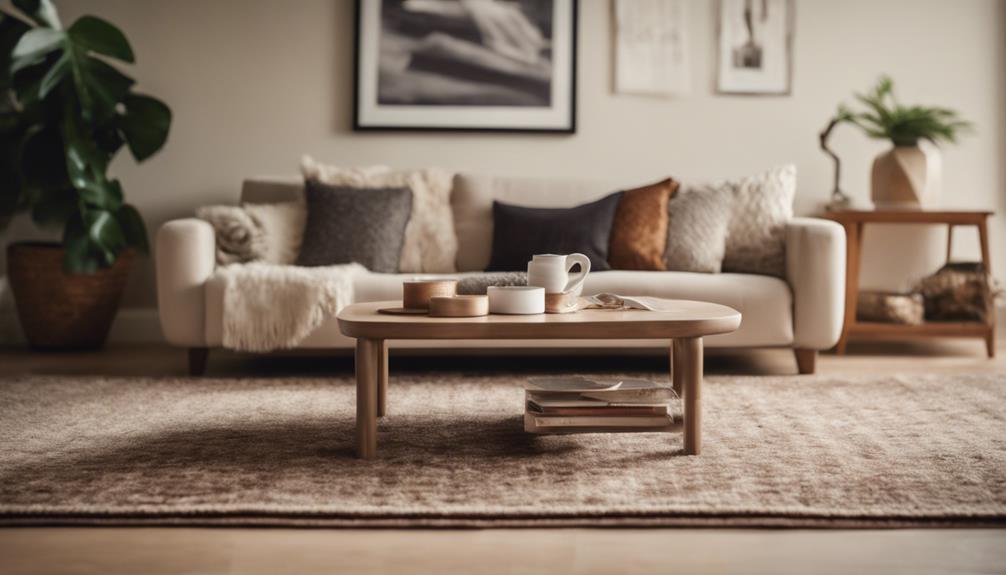To guarantee tanning bed safety, it's essential to know your skin type and limits. Start with short sessions based on your type: if you burn easily (Type 1), limit exposure to 1-3 minutes, while those with medium skin (Type 2) can begin with 4-8 minutes. Gradually increase exposure, monitor for redness, and never ignore signs of overexposure, like peeling or dizziness. Always stay hydrated and moisturized, and use protective goggles. Following these guidelines can help minimize risks and maintain your skin's health. There's a lot more to explore about maximizing your tanning experience safely. In addition to practicing safe tanning bed usage, it’s important to recognize the potential benefits. Tanning beds can help stimulate the production of vitamin D, improve skin conditions like psoriasis, and boost mood through the release of endorphins. However, it’s crucial to balance these benefits with the necessary precautions to prevent any potential harm to your skin and overall health. Understanding the fine line between tanning bed benefits and risks will help ensure a positive experience. To maximize your tanning bed session, consider using a tanning lotion to enhance the effects and protect your skin. Additionally, make sure to give your skin time to recover between sessions and avoid excessive exposure to UV radiation. By following these tips, you can enjoy the benefits of tanning beds while minimizing potential risks to your skin and overall health. Remember, moderation and proper precautions are key to a safe and enjoyable tanning experience.
Key Takeaways
- Identify your skin type using the Fitzpatrick Scale to determine safe exposure times and limits.
- Start with shorter sessions in lower-level tanning beds to gradually build your tan.
- Monitor your skin for signs of overexposure, such as redness, peeling, or tenderness.
- Stay hydrated and moisturized before and after tanning to maintain skin health.
Understanding Skin Types
Understanding your skin type is vital for safe tanning, as it determines how your skin reacts to UV exposure and helps you choose the right tanning bed settings.
Skin types range from Type 1, which burns easily, to Type 5, which is more resilient. If you have Type 1 skin, limit your initial exposure to just 1-3 minutes. For medium skin types, starting with 4-8 minutes is ideal.
Regularly monitor your skin's response to tanning; redness or tenderness indicates overexposure. It's important to consult a professional for personalized guidance.
Tanning Bed Levels
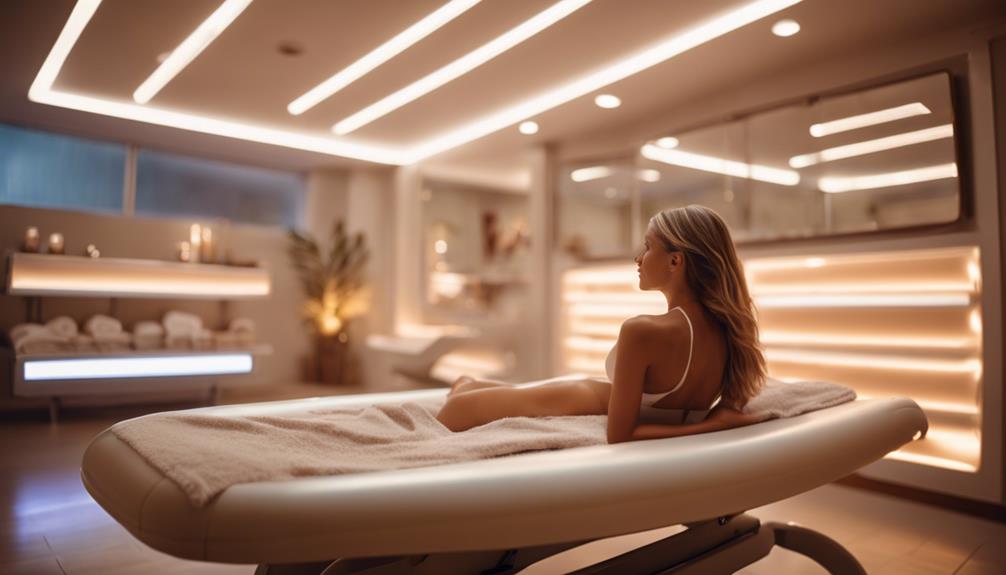
Which tanning bed level you choose plays a crucial role in achieving your desired tan while managing skin safety. Tanning beds are categorized into levels based on their UV output, so understanding these can help you make informed decisions.
- Level 1: Gentle UVA/UVB rays for beginners.
- Level 2: Moderate intensity for a deeper tan.
- Level 3: Higher intensity suitable for experienced tanners.
Always consider your skin type when selecting a level, as overexposure can increase skin cancer risk.
Start slow, monitor your skin's response, and adjust your tanning sessions accordingly to enjoy a beautiful, safe tan.
Session Frequency Guidelines
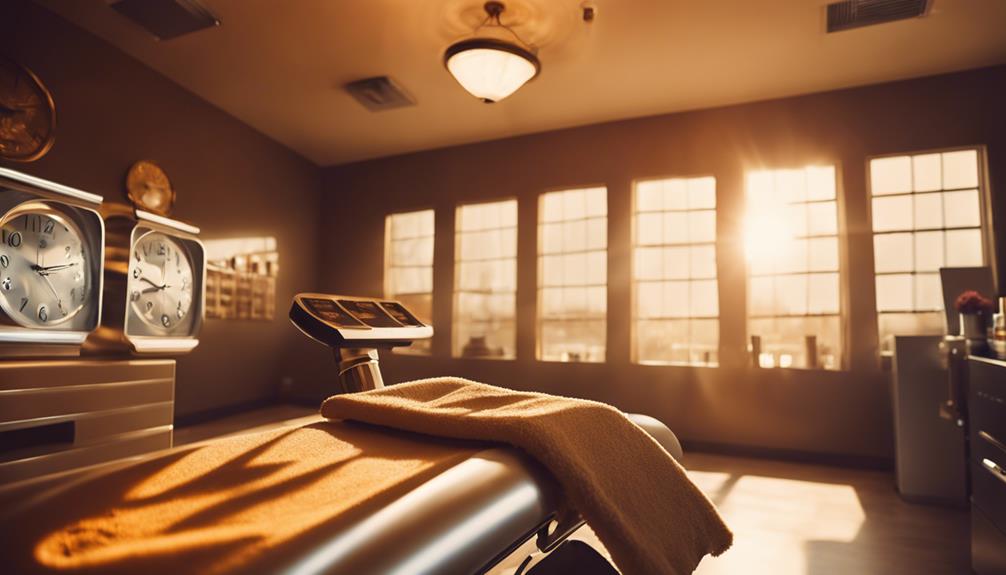
To maintain skin health while tanning, it's vital to follow specific session frequency guidelines based on your skin type and tanning bed level. Here's a helpful reference to guide your tanning schedule:
| Skin Type | Tanning Bed Level | Recommended Sessions per Week |
|---|---|---|
| Type 1 | Level 1 | 1-2 |
| Type 2 | Level 2 | 2-3 |
| Type 3 | Level 3 | 3-4 |
| Type 4 | Level 4 | 1-2 |
| Type 5 | Level 3 | 3-5 |
Keep in mind that your skin's response is significant in determining the right frequency. Monitor how your skin reacts and adjust your sessions accordingly to avoid overexposure and maintain a healthy glow.
Safety Precautions
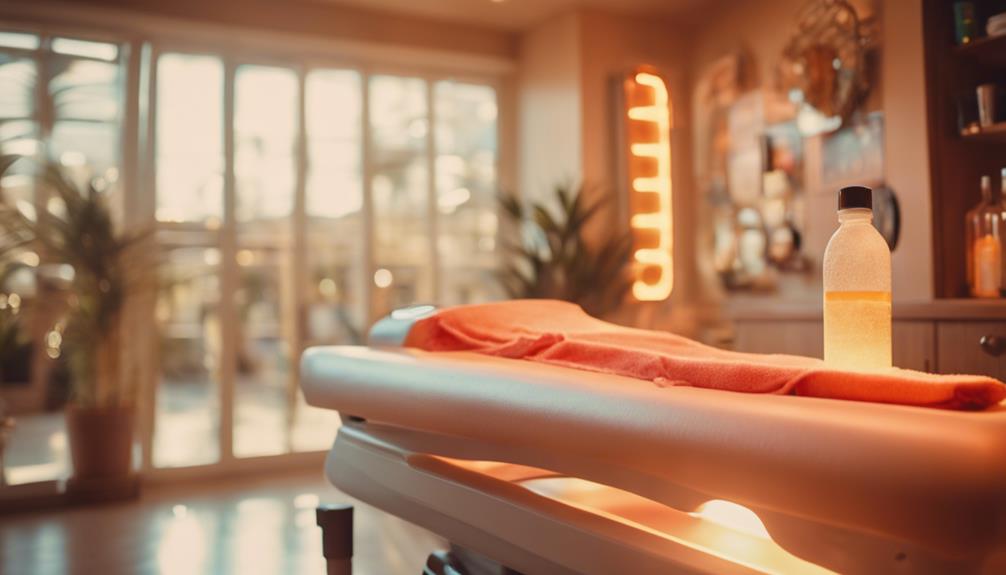
Prioritizing your skin's safety during tanning sessions is essential for minimizing risks and achieving a healthy glow. To guarantee a safe experience, follow these key precautions:
Understand your skin type using the Fitzpatrick Scale to determine appropriate exposure times.
Gradually increase tanning bed exposure time, starting with shorter sessions to avoid burns.
Hydrate and moisturize your skin before and after tanning to maintain its health.
Exfoliate your skin prior to tanning for an even application, and avoid wearing makeup at the salon.
Recognizing Overexposure Signs

Regularly monitoring your skin during tanning sessions helps you recognize signs of overexposure early.
Pay attention to any redness or tenderness, as these are clear indicators that you've had too much UV exposure.
If you notice peeling or blistering, it's time to stop immediately; these are serious warning signs.
Feelings of dizziness or nausea also signal that you need to end your session right away.
Uneven skin color changes can indicate that you're overdoing it, too.
Additionally, if you experience eye discomfort or vision changes, cease tanning immediately and consult a professional.
Always listen to your body; it knows when enough is enough.
Being aware of these signs can help you maintain healthy skin while tanning.
Post-Tanning Skincare
After your tanning session, applying a soothing lotion or aloe vera helps retain moisture and promotes skin recovery.
It's crucial to care for your skin post-tanning to keep it healthy and vibrant. Remember to hydrate and wear breathable clothing to aid in recovery.
- Increase your water intake to maintain skin hydration.
- Exfoliate gently a few days later to enhance the appearance of your tan.
- Use sunscreen before outdoor exposure to protect against UV rays.
Current Tanning Trends
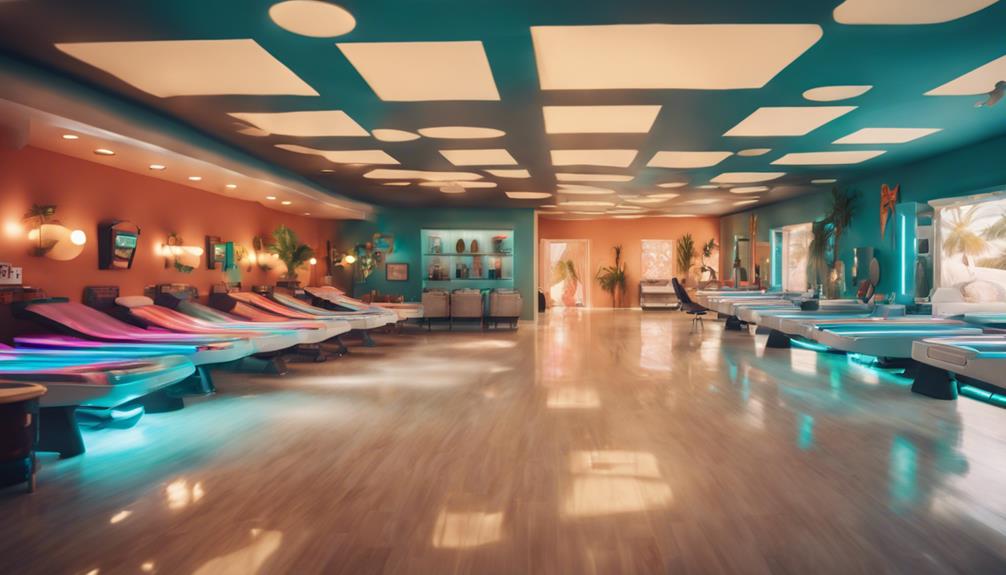
As you focus on post-tanning skincare, staying updated on current tanning trends can enhance your overall tanning experience and keep your skin looking its best.
One trend gaining traction is the use of high-quality tanning bed face covers, which protect your delicate facial skin from UV damage while allowing for a bronzed look.
Additionally, many are opting for natural and organic self-tanners that provide a safer alternative to traditional tanning beds.
You might also find that pre-tanning skin preparation, like hydration and exfoliation, is becoming more popular.
Don't forget to invest in quality tanning bed goggles for eye protection.
Frequently Asked Questions
Can I Tan if I Have a Skin Condition?
You should consult a dermatologist before tanning if you have a skin condition. They'll assess your specific situation and recommend whether tanning is safe or if alternative options would be better for your skin health.
Are There Age Restrictions for Using Tanning Beds?
Yes, many places impose age restrictions on tanning bed use. Typically, you're required to be at least 18, but some facilities may allow younger users with parental consent. Always check local regulations before tanning.
What Should I Do if I Miss a Tanning Session?
If you miss a tanning session, don't worry—about 70% of regular tanners miss sessions occasionally. Just pick up where you left off, adjusting your next session based on your skin's response and needs.
Can I Use Tanning Beds While Pregnant?
You shouldn't use tanning beds while pregnant. The UV exposure can harm both you and your baby. It's best to consult your doctor for safe alternatives to achieve that glow during your pregnancy.
How Do Tanning Beds Affect Different Hair Types?
Imagine Sarah, who loves her vibrant red hair. Tanning beds can lighten your hair color, making it less intense and potentially causing dryness. Always consider how UV exposure impacts your hair's health before tanning.
What are the Limits for Using Tanning Beds Safely?
When it comes to tanning beds, it’s important to master your tanning experience by understanding the limits for safe use. Experts advise limiting sessions to just a few minutes to avoid the risk of sunburn and skin damage. Always follow the guidelines provided by the salon to ensure a safe and effective tanning experience.
Conclusion
In the quest for that golden glow, remember your skin's unique story—each type a canvas requiring careful strokes.
By understanding your limits and embracing safety, you can bask in the warmth of the sun without fear.
Think of tanning beds as a dance; when you know the rhythm, you can sway gracefully without losing your balance.
So, step into the light, but do so wisely, and let your skin shine like a radiant sunset, healthy and vibrant.
